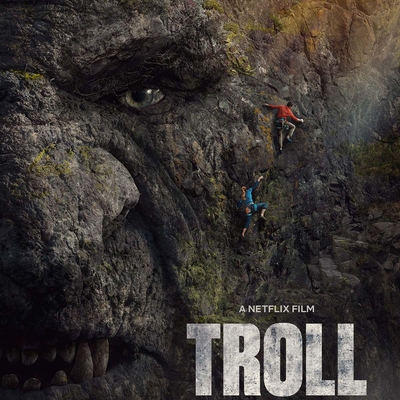A new film for a new year. This December a film described variously as "schlocky" and a "b-movie" unexpectedly became the most popular non-English film on the streaming service Netflix. Halfway through the month, Variety reported that the picture had 128 million viewed hours on the platform, beating out other non-English titles like Blood Red Sky, a German action film with 110 million hours, The Platform, a 2019 Spanish sci-fi horror film (108 million hours) and All Quiet on the Western Front (101 million hours).
The film was Troll, a Norwegian monster movie about a mythic creature that comes to life and terrorizes the country. The film breaks no new ground; quite the opposite, it hits every cliché and trope in the monster movie action film genre like a carillon, but its near (but not total – not in 2022) lack of political or social agenda, not to mention the simple skill of the storytelling makes it an exception to my aversion to writing about new films in this column.
When I saw the trailer for Troll a couple of months ago, I assumed that it was a sequel to Trollhunter (2010), another Norwegian film. I don't know how I ended up being sent a copy of Trollhunter when it came out, not long after I'd been laid off from the daily newspaper job where I reviewed movies and television, but it remains one of my favorite recent films. (A very small list.)
A "found footage" mockumentary directed by André Øvredal, it's the story of a group of film students making a documentary about bear poaching who accidentally film Hans, a troll hunter, going about his very unofficial and covert work. With his help, they uncover a secret government program and an attendant cover-up meant to disguise the existence of multiple species of trolls alive and thriving in the arctic north of the country, some as big as mountains.
What I loved about Trollhunter was its knowing sense of humour, both about the old fairy tales apparently told to every Norwegian child, and about the tropes and conventions of the "found footage" genre – pretty much played out in the decade since it came into its own with The Blair Witch Project (1999). It was a low budget film, made for the equivalent of US$3.5 million, with special effects that looked like they cost much more, like Monsters (2010), a tiny but evocative sci-fi picture released the same year, both films a testament to what was possible with digital effects that could be created on a laptop.
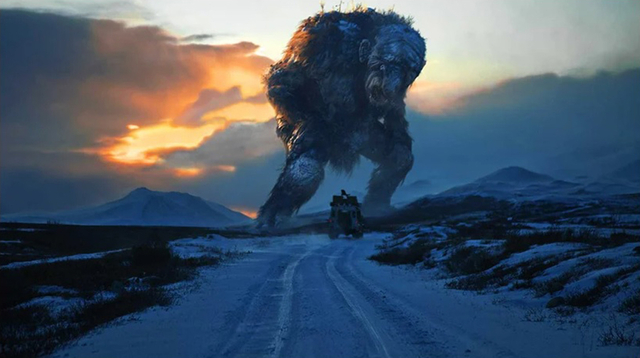
Øvredal went on to make the English-language horror films The Autopsy of Jane Doe (2016) and Scary Stories to Tell in the Dark (2019), before returning to Norway to make Mortal (2020). His new picture, The Last Voyage of the Demeter, is due out in the coming year, and is based on a chapter of Bram Stoker's Dracula. I had hoped he'd been given a chance to explore the world he created in Trollhunter, but the two films are apparently unrelated (though there's no reason they have to be. More about that later.)
Norway has had a quiet cinematic renaissance in the last few years, with everything from the wry romantic comedy The Worst Person in the World (2021) to the war movie The King's Choice (2016) to a trilogy of disaster movies – The Wave (2015), The Quake (2018) and the recent and rather disappointing The Burning Sea (2021). The magnificently named Roar Uthaug was the director of The Wave, and made the 2018 reboot of Tomb Raider before directing Troll for Netflix.
The film begins as the camera flies over the spectacular mountain peaks in Romsdalen, in the northwest of Norway between Bergen and Trondheim, and rests on Trolltindende – the Troll Peaks, where a father and his daughter are scaling a sheer rock cliff face. (Apparently a family bonding activity in Norway.) Tobias (Gard B. Eidsvold) and Nora (Ameli Olving Sælevik) make it to the peak, where the father reminds his daughter of the old story about how the Troll Peaks were formed, when a bunch of trolls drank too much at a wedding feast and were turned into stone by the morning sunlight.
Nora says she doesn't believe in fairy tales anymore, but her father says that there's an element of truth in every old story. He tells her that instead of having to see something to believe it, he thinks you need to believe to see, and right on cue the sun changes and the faces of the trolls are revealed in the stones of the mountain wall across the valley.
We meet Nora (Ine Marie Wilmann) again twenty years later, a paleontologist at a dig on the Norwegian coast. Funding is running out on the project and they'll be going home empty-handed, but Nora has a hunch and sure enough she finds a massive theropod skull, buried not beneath metres of sedimentary rock but a few feet beneath the topsoil on the beach. (This is the sort of archaeological improbability that must make experts wince, but which we have to blithely accept in the name of building up a character and a story as quickly as possible.)
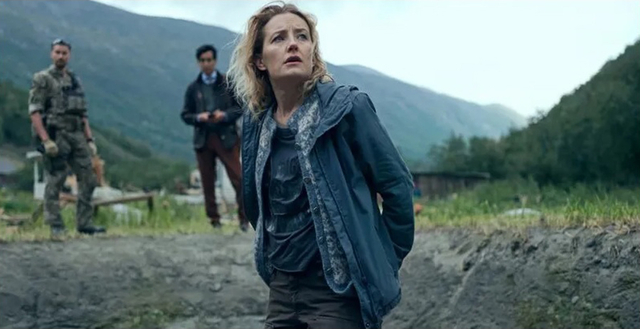
Cut to the Dovre Mountains, in the centre of the country, where workmen are blasting to make a tunnel for a high-speed train while eco protesters (mostly young women) chant and hold up placards, pleading to "let the mountain live." A detonation of the rock wakes something up, and it roars while chasing the workers and exploding out of the mountain, crushing protesters under rocks and debris.
Cut again to the headquarters of the Norwegian Armed Forces under Akershus Fortress in Oslo, where the young soldiers manning the walls of computer screens are alerted to sudden seismic activity. Fighter aircraft are scrambled; cameras beam footage of a massive crater where the tunnel head was; the top brass squint with concern at the screens and put in a call to the Prime Minister.
Nerdy Andreas (Kim Falck), an aide to the Prime Minister (Anneke von der Lippe), stands by her motorcade in the rain holding an umbrella, and tells his boss that the defense minister will brief her on the way. No one knows what happened, but they agree that experts are needed and Nora, celebrating with her team, gets gathered up by a helicopter and flown to Akershus, where she's met by Andreas.
On their way through the command centre, Andreas flashes the Vulcan greeting to Sigrid, a nerdy uniformed information officer - a geek high sign that we know will pay dividends later in the movie. (Every good disaster film comes front loaded with an arsenal of Chekhov's guns. And I'm not talking about the Star Trek Chekhov.) The army speculates about a missile strike, a terrorist attack or a geological event, and a pair of geologists sitting on either side of Nora suggest that the trail of indentations leading from the tunnel might be karst sinkholes or underground gas accumulation – "methane, as a consequence of climate change."
"We'd better call Greta, then," the defense minister mutters.
Nora wonders aloud if this is all a joke, and when reassured by the Prime Minister that it isn't, asks why everyone can't see that the huge indentations are tracks – footprints left by massive feet. She's being mocked by the defense minister and the geologists when Sigrid rushes in and shows them hacked cellphone footage shot by a protester, with a single blurry frame showing a huge creature roaring at the centre of the rocks and debris.
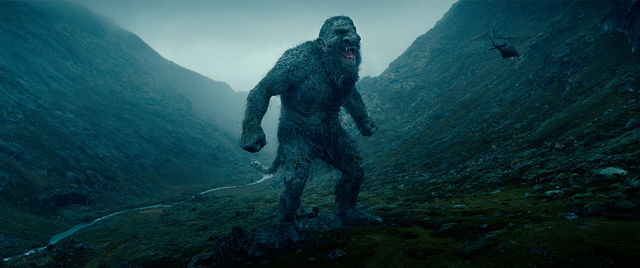
We are, at this point, less than fifteen minutes into the film and Uthaug has briskly dispatched all the scene-setting elements for a creature feature disaster film like boxes that have to be checked. It's all very efficient and economical and, yes, utterly conventional. The genre's genesis is, of course, King Kong (1933), but nearly every element that Troll connects like pieces in an old puzzle were put in place by Ishirô Honda's Godzilla (1954).
Cut to a cabin in Lesja, in a valley south of the Dovre Mountains, where a retiree couple are enjoying their tea while their dog barks at something unseen. Ripples in their teacups – a tribute to Jurassic Park – signal the imminent arrival of whatever came out of the mountain, and the old couple barely have time to escape to their basement before that something demolishes the house above them.
The Prime Minister decides that Nora will be her scientific adviser and sends her in another helicopter with Andreas as her minder. On the way to Lesja they share some backstory: her father was a professor of folklore, her mother died when she was ten; there's been a rift between them. Andreas wanted to be a writer; he's working on a book about a monk who can pull off his own head and use it as a weapon. He doesn't get much further than that before they arrive at the demolished cabin and the fresh giant footprints leading away from it.
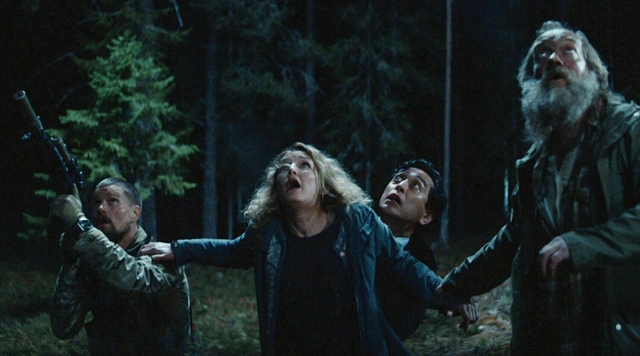
On the ground they meet Captain Kris (Mads Sjøgård Pettersen) from Norwegian special forces, and by just over twenty-one minutes into the picture we've met the youthful trio of protagonists we'll follow for the rest of Troll. But before they can go any further they have to consult with Tobias, and provide the reunion this kind of story needs to bring science and superstition together.
They find him living in a cabin in Steinbudalen, just by Jotunheimen National Park – a wild-looking, shotgun-wielding old kook wearing no pants, the walls of his cabin covered in notes and drawings. He's the first person to say the word "troll", and he ignores Nora's warning and says it again when they retreat to the army command centre, after they wake up a troll, sleeping camouflaged but in plain sight in the park.
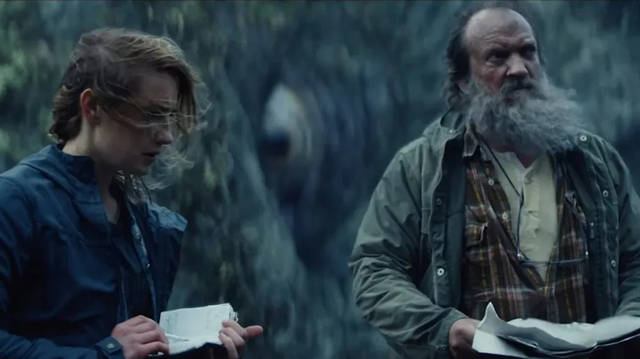
Even with clear video footage and eyewitness testimony the politicians and generals in Akershus can't bring themselves to call the thing what it is. What they do know is that they need to call in the army, which is the cue for tank shells and missiles to bounce off the mountainous giant, just as they only irritated Kong and Klaatu and Godzilla. Among the casualties of the battle in the night is Tobias, along with a wounded soldier who's snatched up and eaten by the troll while he prays.
Fee fi fo fum,
I smell the blood of a Christian man.
Be alive, or be he dead,
I'll grind his bones to make my bread.
English readers of Tom Thumb would know this rhyme about giants and English men, but the scholarship in an 1814 book, Illustrations of Northern Antiquities, connected it to much older stories from Scandinavia, and everyone in Troll and Trollhunter knows what it really means.
This is the basis of one of the best grisly jokes in Trollhunter, after Hans asks if any of the young student filmmakers are Christians. This is modern, socially democratic Norway, so they all insist they aren't, but Kalle, their cameraman – an irreverent, irritating wannabe hipster – is secretly in denial of his unfashionable faith and gets eaten by cave trolls who can smell it on him. His replacement from the film school is Malika, a young Muslim woman. Hans finds this intriguing.
"Let's see what happens," he says with a shrug.
"It's details like this which make a silly movie about trolls really funny and really fascinating," wrote Erik Kain in a 2011 Forbes article about Trollhunter. "In many ways, it's a story about the loss of faith in the face of modernity. Hans is lost somewhere between these two worlds – one ancient and forgotten, the other bleak and ordered. Not that the film asks us to over-think this sort of thing."
We know Troll can't end without at least one scene showing the devastation of some beloved national landmark. On his rampage south from Jotunheimen to the capital, the troll causes havoc at Hunderfossen Adventure Park, just outside Lillehammer, and once he's in Oslo he casually smashes the Freia neon sign and clock on Karl Johans gate – the film's equivalent of the ritual destruction of the Eiffel Tower or the Hollywood sign.
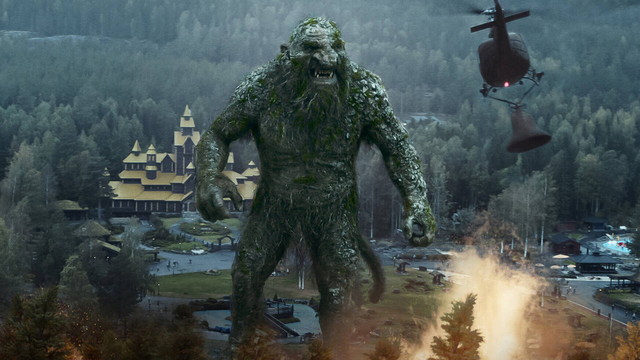
You could call this a lack of originality or say it's Uthaug showing respect for the conventions of the genre. I did find myself calling out plot points well in advance of them happening – something my family and friends love me doing – but is this really worth criticizing with the sort of film we slip into like a warm bath?
But Troll is a modern creature feature disaster film and as such isn't complete without some sort of conspiracy. In Trollhunter we learned about the secretive troll hunting work going on behind the façade of the fish and game department, and how a network of hydroelectric power lines in the north of the country were really an electric fence to keep the largest of the troll species confined to their sub-arctic wasteland.
In Troll Tobias rants that the conspiracy to deceive the public about the existence and nature of trolls extended to the work of artists and folklorists like Theodor Kittelsen, Peter Christen Asbjørnsen and Jørgen Moe, who created misinformation that enabled the fairy tale cover stories. The trail leads all the way to the Norwegian royal family and their Royal Palace at the end of Karl Johans gate.
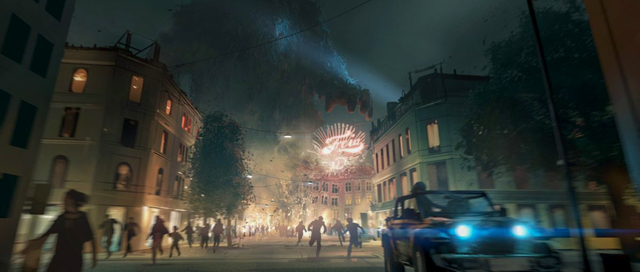
Tobias leaves behind a series of gnomic clues that Andreas is able to interpret, and with the monster on his way to the capital, he leads Nora to Sinding (Bjarne Hjelde), chief of court at the palace, who apologizes for how the government had locked up her father when he got too close to the truth, before taking her to tunnels under the palace where at least a dozen skeletons of a troll royal family have been hidden, massacred by St. Olaf. Ancient people liked to build their palaces on the castles of conquered foes, and the palace on the Bellevue rise was built on the Hall of the Mountain King – precisely where the reawakened troll is heading.
And as with Kong and Godzilla, we're encouraged to sympathize with the monster who, after all, had been done a great wrong and was disturbed, driven or abducted from his home; like so many great monster movies, it's all about humans committing sins against nature and paying the price. It's a perennially popular story, never more so than today, in the age of climate panic.
Sigrid the hacker plays a crucial role, breaking into the targeting system to stop the jets sent to fire a tactical nuke at the monster right in the centre of Oslo. (Does Norway even have nukes? The country has never signed the Treaty for the Prohibition of Nuclear Weapons. That seems to be enough for the filmmakers behind Troll.) She even gets her girl boss moment and decks the blowhard minister of defense when he tries again to send the missile on its way, to the approval of steely General Lunde (Dennis Storhøi), the chief of defense.
If Troll is hiding any political message, it's hinted at when Tobias states that the Christianization of Nordic, Viking Norway was what drove the trolls to extinction; by implication the secularization of modern Norway is the cue for trolls to return, and in a mid-credit sequence at the end of the movie the sequel is set up, pending Netflix approval.
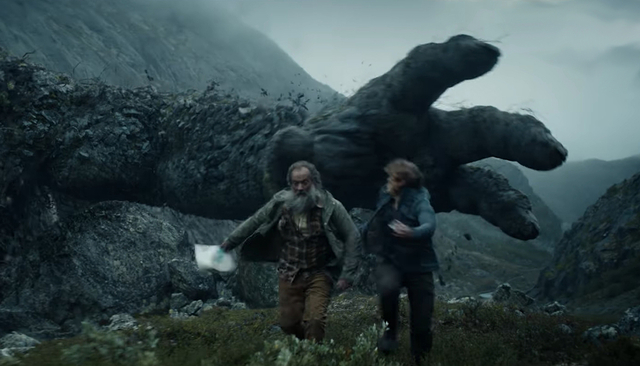
Movie franchises are all about lore and canon, so I see no reason why Trollhunter can't be retconned into the Troll universe, with government agencies so secretive and off the books that one has no clue what the other is doing. It certainly helps expand the scope of a conspiracy that has to – with luck – encompass at least two more pictures, and while Troll does a fine job creating an epic adventure, the earlier film is much richer in character and backstory.
In the Forbes article, Kain beautifully explains the appeal of the titular troll hunter: "Hans is sick of his thankless government job. He can't sleep in the dark. He's always on the move. The pay is bad and the hours are worse. Every time he kills a troll he has to fill out a bunch of paperwork. His boss is a jerk. The mundane bureaucratic red tape is fleshed out in marvelous detail."
Both films build their lore on fairy tales, and on the idea that we lost access not just to wonder but to truth when we either leave them behind or incorporate them into modern bureaucracy. Tobias is sad that Nora has lost the sparkle in her eye from when they shared a belief in the wonder of so-called myths, abandoned when she became ashamed of him and embraced simple logic. Hans should be living a life of adventure, but he feels like an exterminator.
Of course fairy tales have never gone away – we've just disguised them behind the tropes of genre movies, like horror and fantasy, kaiju, sci-fi and adventure. If films like Trollhunter and Troll add anything new – and I'm not sure if they do; the grisly original tales told by the aptly-named Brothers Grimm are full of cover-ups and hidden crimes committed by royal families and evil parents – it's to allow our mistrust of government and the "official story" to become essential and unquestionable assumptions we make along the way to revealing the truth.
Mark Steyn Club members can let Rick know what they think by logging in and sharing in the comments below, as access to the comments section is one of many benefits that comes along with membership in the Mark Steyn Club.


